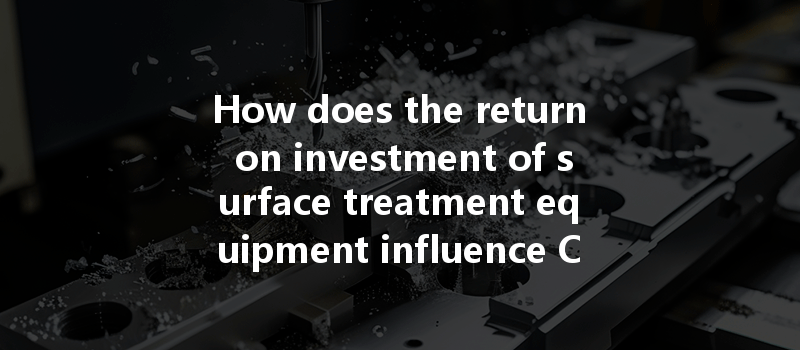Did you know that over 70% of manufacturers cite surface treatment as a critical factor in determining the durability and performance of their machined parts? This striking statistic sheds light on the importance of surface treatments and the decision-making process surrounding their integration into CNC machining workflows. As the landscape of manufacturing continues to evolve, understanding how the return on investment (ROI) of surface treatment equipment directly impacts CNC machining material selection becomes imperative for any business looking to optimize performance and profitability.
Surface treatment processes—ranging from anodizing and electroplating to powder coating and polishing—can dramatically improve the characteristics of materials used in CNC machining. Their application influences not just the required type of materials but also the overall cost, production timelines, and the quality of the final product. With this in mind, let’s delve into the nuances of how ROI on surface treatment equipment can guide material selection in CNC machining.
Understanding Surface Treatments
Before diving into how ROI affects material selection, it’s essential to understand what surface treatments entail and why they are applied in the first place. Surface treatments enhance the physical and chemical properties of materials, improving their:
These enhancements allow manufacturers to use a wider variety of materials in their CNC machining processes while achieving the desired performance metrics.
Common Types of Surface Treatments
Each of these treatments involves specific equipment and technologies, impacting the ROI.
The Impact of ROI on Surface Treatment Equipment
Understanding the ROI on surface treatment equipment is crucial for material selection. The investment in such equipment often involves significant upfront costs, ongoing maintenance expenses, and operational costs associated with processing time and resources. Here’s how these factors can influence material selection:
Investments in advanced surface treatment technologies can be substantial. Reliable estimates suggest that acquiring high-quality anodizing and electroplating equipment could cost anywhere from $100,000 to over a million dollars, depending on the scale of operations.
The implications for CNC machining are significant; if a recent investment is made in surface treatment technology, it might be more cost-effective to select materials that will maximize the operation of that equipment. For example, if an organization invests in anodizing equipment, prioritizing aluminum alloys that benefit from anodization could improve both the parts’ performance and the ROI on the equipment.
Efficiency is another crucial aspect that directly affects ROI. If the surface treatment process is slow or cumbersome, the overall production time increases, which can lead to higher operational costs. In light of this, choosing materials that optimize processing speed is vital. For instance, some materials may require less processing time and fewer steps during surface treatment, improving overall efficiency and ultimately providing a favorable ROI.
When considering the long-term aspects of ROI, it’s essential to think beyond initial costs and examine the durability of parts. A surface treatment might yield higher initial costs, but if it significantly extends the life of a product, the ROI increases. For instance, selecting corrosion-resistant alloys for outdoor structures can prevent costly repairs and replacements in the long run.

Businesses today are also increasingly concerned about sustainability. Choosing environmentally friendly surface treatments can lead to regulatory compliance and enhanced brand reputation. The ROI associated with being environmentally conscious can translate to customer loyalty and potentially higher sales, making it an essential consideration in material selection.
Materials Commonly Selected for CNC Machining with Surface Treatments
Understanding how to navigate material selection in the context of surface treatment ROI involves knowing which materials will benefit from certain processes.
Comprehensive Solutions for Optimizing ROI in CNC Machining
While surface treatments heavily influence material selection, taking a comprehensive approach is vital for enhancing ROI. Implementing integrated solutions that consider both CNC machining and surface treatments will yield superior results.
Using data analytics to review past projects and material performance can offer insights into which combinations yield the best ROI. Tracking metrics such as operational costs, failure rates, and production timelines will guide future material selections and investments in equipment.
Investing in staff training can minimize errors in the machining and surface treatment processes. Well-trained employees will handle materials effectively, maximizing the return from equipment investments.
Encouraging a culture of continuous improvement can yield innovative practices that reduce costs and waste. Regularly evaluating processes will help industries adapt to changing technologies in both CNC machining and surface treatments.
Building strong relationships with material suppliers can lead to better pricing and availability of high-quality materials that work well with specific surface treatment techniques. This collaboration contributes to overall cost savings and enhanced production efficiency.
In the fast-paced world of CNC machining, optimizing material selection through a thorough understanding of the return on investment of surface treatment equipment is not just beneficial, but essential. As we’ve explored, upfront costs, efficiency, durability, and environmental considerations are all crucial components that must be weighed when making decisions.
Recognizing the interplay between surface treatments and material selection can lead to enhanced product performance, longer product lifetimes, and reduced operational costs. Thus, businesses that educate themselves on the implications of ROI related to surface treatment processes are better positioned to make informed decisions, ensuring both profitability and sustainability.
As you contemplate your future CNC machining projects, remember the importance of selecting the right materials with appropriate surface treatments to take full advantage of your investments. This strategic approach not only enhances product quality and longevity but also solidifies your competitive advantage in a constantly evolving market.
Understanding and implementing these techniques could truly be the difference between a successful and a lackluster production cycle. The investment in knowledge is worth it—now is the time to act and make these integral considerations part of your operational strategy.






